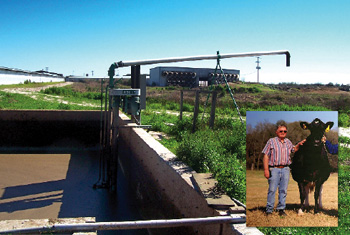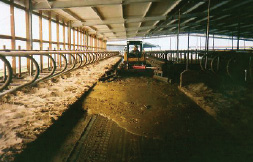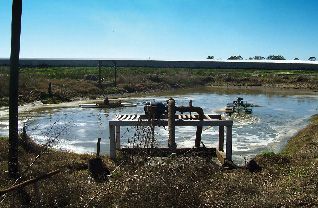
Features
Applications
Beef
Making the right manure management choice
April 1, 2008 by Paul MacDonald
Florida’s largest dairy operation,
North Florida Holsteins, will be making significant changes to its
manure management system in the near future and is doing its due
diligence to ensure the right choices are made.
Florida’s largest dairy operation, North Florida Holsteins, will be making significant changes to its manure management system in the near future and is doing its due diligence to ensure the right choices are made.
 Don Bennink (above, inset) says North Florida Holsteins is looking to make changes to its manure management system that fit with the professional and proactive approach the dairy takes in all its operations. Don Bennink (above, inset) says North Florida Holsteins is looking to make changes to its manure management system that fit with the professional and proactive approach the dairy takes in all its operations. |
Dairyman Don Bennink and his partners at the North Florida Holsteins dairy recently marked 25 years of operations in the Sunshine State, and it has been a period of time marked by substantial growth of this progressive farm operation.
Bennink moved the dairy operation from New York State to Florida in 1980 and set up the farm with about the same number of Holstein cows, about 125. In addition to operating a dairy in western New York State, Bennink was also a practicing attorney at the time. “I happened to be down in northern Florida on a case and I thought the area had a lot of opportunity, so we made the big move.”
At the time, a herd of 125 was a good size, whether by New York or Florida standards. But as Bennink notes, there was plenty of opportunity—the dairy grew to 1,000 cows by the mid-1980s, 2,000 cows by the late-1980s and 3,000 cows by the early 1990s.
North Florida Holsteins now has 3,700 head of milking-age females, and young stock brings the total number of animals to 6,400. North Florida Holsteins is the largest single dairy operation in Florida. The farm is set up on 1,250 acres, about 30 miles west of Gainesville, in the agricultural town of Bell, Florida.
Like many dairy operations, North Florida Holsteins is now at a crossroads when it comes to dealing with the manure from its large herd. But having engaged the services of consultant Raymond Hunter, they’ll soon be choosing which path to take.
Part of the driving force behind the move to stepping up its manure management is the professional and pro-active approach that North Florida seeks to take in all of its operations. In fact, it was honored with the 2005 Innovative Dairy Farmer of the Year award, which is co-sponsored by the International Dairy Foods Association.
The farm’s motto is “Quality Milk from Comfortable Cows,” the latter an important point considering the region’s hot and humid weather. The most recently built freestall barns have been constructed with tunnel ventilation for climate control and heat stress reduction, and grooved rubber flooring for animal safety and comfort.
The entire herd is housed in barns, most in tunnel ventilation barns. Additional cooling is provided by sprinkler systems over feedbunks and shade structures in lots. All outside lanes are covered in cow carpet for cleanliness and stress relief in wet weather. The newest addition is a 750-foot tunnel ventilation barn, which holds 900 cows in six rows of freestalls. A total of 60 Acme 51-inch fans exchange the barn air every 40 seconds. Two 640-foot barns are cooled by 38 Acme 51-inch fans powered by one horsepower motors. Air is exchanged in these barns every 62 seconds. The remaining 280-foot barn has 30 Acme 48-inch fans powered by one horsepower motors, and the air is exchanged in this barn every 47 seconds.
North Florida Holsteins has its own Mission Statement, which includes the objectives of operating in a safe and environmentally friendly manner, and being an industry leader. “We’re meeting all the necessary regulations in terms of manure management, but we’re not satisfied with where we are now,” explains Bennink, who is the dairy’s managing partner. “We’re at that stage where we want to look at the various systems, and see how they would work in terms of costs.
 Putting their manure to work, in terms of installing a digester and energy production system, is an option for North Florida Holsteins. The dairy would have a ready-made customer for power in the form of a nearby cement plant. Putting their manure to work, in terms of installing a digester and energy production system, is an option for North Florida Holsteins. The dairy would have a ready-made customer for power in the form of a nearby cement plant. |
“We’re exploring and looking at the options, and laying out a plan for future manure management. Should we incorporate in systems for direct nutrient removal and should we incorporate in any energy systems?”
These are questions that many large dairy farmers in the US are now facing.
North Florida Holsteins chose to employ the services of a consultant simply because of the large number of options in the market, as well as market players and equipment suppliers.
“There are a lot of systems out there, and we want to have Raymond Hunter help us make the right choices.” Importantly for North Florida Holsteins, Hunter, as an independent consultant, is not tied to any system. They have given him the mandate to explore the complete spectrum of manure management options, including looking at what some municipalities are working with in waste management.
“There are some municipalities doing pretty interesting things, methods that claim to remove the ammonia from the waste and deliver aluminum sulphate fertilizer, among other things,” says Bennink.
“Raymond’s job is to explore all of the options from land spreading, cleaning up the nutrients and energy production, or any combination of those.”
Cost, of course, is going to be a consideration. It is presently costing North Florida Holsteins about 1.5 cents a gallon for custom application. “What we are doing now is not low cost, but when you start looking at other systems, such as those involving flocculating chemicals and other chemical set-ups, it doesn’t look too bad.”
In the case of installing a digester and an energy production system, the dairy would have a ready-made customer in the form of a nearby cement plant. Recent higher energy prices are making energy-from-manure power production attractive. But energy prices, as farmers know only too well, have been very volatile.
“The price of natural gas late last year was 15 cents a decatherm and as of the beginning of this year, it was eights cents,” says Bennink. If they opt for the energy path, they will need to be prepared to handle that kind of volatility, he adds. That said, the lower energy prices seen more recently are still historically high. “These kinds of prices are still relatively high, and look attractive,” he notes. Added to this is Bennink’s conviction that dairies have to move away from aeration in manure lagoons. “Passing methane and carbon dioxide into the atmosphere is a short-term solution, but that’s not the direction we want to go in the future.”
The direction they decide to go in could influence the manure systems the farm has in its eight barns. Some of the barns are on flush systems, and they may be converted over to slurry operations. Honey Vacs units handle some of the manure.
Right now, Knight spreaders and Houle tankers pulled by John Deere tractors are regulars at the dairy’s lagoons. The farm has three concrete lined lagoons, with total storage capacity of 1,450,000 gallons, along with several concrete lined slurry holding areas. In the main lagoon, a Houle agitator pumps to a Cornell step-up pump to flush water to the pivot systems. The slurry in the holding areas is handled and agitated with Houle pumps, ranging in power from 30 to 40 horsepower.
North Florida Holsteins puts up approximately 42,000 tons of corn silage, 3,500 tons of ryegrass silage, 4,000 tons of sorghum silage, 8,000 tons of Bermuda grass, and 6,000 tons of other silages annually. Part of this is raised on their own acreage, and manure diluted with water is sprayed over large areas by a center-pivot irrigation system. Some of the manure is also applied on other farms, with transport and application done by custom applicators.
 The farm now has three concrete lined lagoons, with total storage capacity of 1.45 million gallons, along with several concrete lined slurry holding areas. The farm now has three concrete lined lagoons, with total storage capacity of 1.45 million gallons, along with several concrete lined slurry holding areas. |
“The manure hauling equipment is going up and down the highway, and that’s not ideal. Should we be looking at truck-mounted tanks? It would be good to have the same vehicles that are moving the manure applying in the fields, doing a minimum amount of soil compaction moving on and off the land.”
The current review process gives them the opportunity to see if it makes sense for North Florida to purchase its own manure application equipment or whether using custom applicators is the more economical solution. They will also be determining exactly what their equipment, or the custom applicator’s equipment, will be hauling.
“A lot certainly depends on how much we need to concentrate the nutrients before we haul it,” says Bennink. They’d like to reduce the water content of the hauled slurry, and this would mean the installation of separation equipment. “If we can haul it in one load, instead of four loads, is it worth the capital expenditure for the equipment?” says Bennink. There is also the learning curve associated with putting in new equipment, and training farm staff.
Even though North Florida Holsteins is in an ag region of Florida—the area around the town of Bell is the second largest dairy area in the state with a number of other large dairies with anywhere from 1,000 to 4,000 cows—it is still subject to development pressures. This area of Florida, unlike south Florida, is less subject to the high winds and damage from the hurricanes that hit the state. As a result, many people have moved north, and this has brought plenty of development in the area. The perimeter of the farm’s crop land has lots of houses, although they are often on larger lots of five or ten acres. “But the number of these has probably doubled in the last few years,” says Bennink.
The new arrivals, unlike residents who have lived in the area for a while, are likely to be less tolerant of the smells that emanate from dairy operations. “That’s quite true,” says Bennink. “But a lot of how we get along with these people is going to be determined by what we the dairies do to be good neighbors.”
That said, odor removal is going to be one of the driving forces in the manure management approach the farm adopts. “Spraying fields, unless you doing a fair amount of nutrient removal, is not a way to make good neighbors.”
With his background as an attorney, Bennink is well aware of the legal complications that can be caused by unhappy neighbors. But with their pro-active and environmental approach, that is not something they have run into. “I’d say that we generally have good to excellent relationships with our neighbors.”
Like many dairy operations, how operations are carried out at North Florida Holsteins—including manure management—is an evolving process. Bennink says they expect to have made a decision on a new manure management system later this year, and the pieces will start to come together shortly after. But even with that, they’d like to stay flexible, he notes.
“With the manure stream, we’d like phase it in so we can continue to study the technologies and remain fairly adaptable. We’d like whatever system we go for to be adaptable to what we see as the choices that are going to be on the horizon in manure management, and not lock ourselves into something that doesn’t have flexibility.”
In terms of future growth, Bennink says they’ll be sitting tight with their current herd size. Their size sometimes staggers Bennink, who started out many years ago with a 35-cow herd upon graduation from college.
The cost savings that come with having a large dairy operation, and the accompanying economies of scale, are the primary drivers for large dairies.
“That’s part of the reason,” Bennink says. “As you put together a quality staff, to justify the costs you’ve got to have a large number of cows.” The dairy has 70 employees.
North Florida Holsteins is close to the University of Florida and its College of Veterinary Medicine, which presents opportunities. The farm has cultivated a relationship with the university staff, and makes a sizable number of cows available for research projects, giving them the opportunity to evaluate the results as the trials are completed.
On one project in particular, Bennink has worked pro-actively with the university and government agencies to determine which varieties of grass provide the most efficient uptake of nutrients from the soil. In terms of reducing the overall amount of nitrates entering a nearby aquifer from the farm, the discoveries have been interesting. Grasses like the Tifton-85 Bermuda grass that is being used on most of the fields today can absorb nitrates from the soil through their roots much faster than those which, only a few years ago, were recommended to dairy farmers around the state.
To Bennink and his farm partners, taking advantage of these opportunities is all part of making sure they remain a progressive operation—as will the choices they are soon to make on manure management.